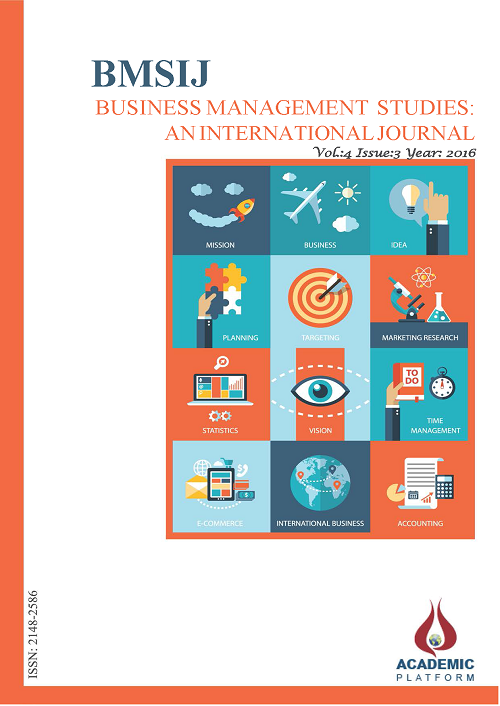
Yayınlanmış 26.12.2016
Anahtar Kelimeler
- İç Denetçi,
- Güzergah Belirleme,
- Fayda Maksimizasyonu
Nasıl Atıf Yapılır
Nasıl Atıf Yapılır
Öz
Çalışmada iç denetçi atama modellerine yeni bir yaklaşım önerilmektedir. Geçmişte yapılmış iç denetçi atama çalışmaları genellikle maliyet minimizasyonu üzerine kurulmuştur. Bunlardan farklı olarak ilgili çalışmanın çıkış noktası ise iç denetçilerin faydalarını maksimize etmektir. Her şubenin konumu, şube büyüklüğü, şube tipi gibi özellikleri dolayısıyla denetçiler için farklı fayda değelerine sahip olduğu fikrinden yola çıkılmıştır. Bu doğrultuda her şube için fayda değerleri belirlenmiş ve iç denetçilerin atanmasında bu faydanın en büyüklenmesinin amaçlandığı bir tam sayılı programlama modeli kurulmuştur. İlgili matetiksel modelin kısıtları, denetçilerin gidecekleri şubelerden elde edecekleri fayda değerlerinin birbirine yakın olması, tüm denetçilerin çalışma günlerinin birbirine yakın olması ve toplam fayda değerlerinin birbirine yakın olmasıdır. Çalışma üç aşamalıdır. Birinci aşama Analitik hiyerarşi prosesi yöntemi ile şubelerin fayda değerleri elde edilmesidir. İkinci aşama simulasyon yöntemi ile her şube için denetim işinin yaklaşık süresi belirlenmesidir. Son aşama ise iç denetçilerin çalışma güzergahlarının belirlenmesi ve toplam çalışma günleri ve toplam fayda bilgilerinin elde edilmesi için matematiksel modelin çözdürülmesidir.
Referanslar
- Abdioğlu, H. (2008). Bölgesel Kalkınma Ajansları: Muhasebe İşlemleri ve Denetimi. I. Güney Marmara Bölgesel Gelişme Sorunları Sempozyumu, Bandırma-Balıkesir.
- Bailey, A. D., Boe, W. J., & Schnack, T., 1974. The audit staff assignment problem: a comment. Accounting Review, pp. 572-574.
- Balachandran, K. R., & Steuer, R. E. , 1982. An interactive model for the CPA firm audit staff planning problem with multiple objectives. Accounting Review, pp: 125-140.
- Balachandran, B. V., & Zoltners, A. A., 1981. An interactive audit-staff scheduling decision support system. Accounting Review, pp: 801-812.
- Blocher, E., 1979. Performance effects of different audit staff assignment strategies. Accounting Review, pp: 563-573.
- Brody, R. G., & Lowe, D. J., 2000.The new role of the internal auditor: implications for internal auditor objectivity. International Journal of Auditing,4(2), pp: 169-176.
- Burkard, R. E. 2002. Selected topics on assignment problems. Discrete Applied Mathematics, 123(1),pp: 257-302.
- Chan, K. H., & Dodin, B., 1986. A decision support system for audit-staff scheduling with precedence constraints and due dates. Accounting Review, pp: 726-734.
- Chang, C. J. (2002). A decision support system for audit staff scheduling of multiple and large-scaled engagements. Review of Business Information Systems (RBIS), 6(1), 27-40.
- Chen, R. C., Huang, C. C., & Suen, S. P. (2012). On the Optimization of Auditor Assignment. In Information and Business Intelligence (pp. 617-622). Springer Berlin Heidelberg.
- Dantzig, G. B., 1954. Letter to the Editor—A Comment on Edie's “Traffic Delays at Toll Booths”. Operations Research, 2, pp: 339-341.
- Dodin, B., & Huang Chan, K., 1991. Application of production scheduling methods to external and internal audit scheduling. European Journal of Operational Research, 52(3),pp:267-279.
- Dodin, B. (1999). Project Management in Audit Staff Scheduling. In Project Scheduling (pp. 509-527). Springer US.
- Edie, L. C., 1954.Traffic Delays at Toll Booths. Operations Research, 2,pp:107-138
- Ernst, A. T., Jiang, H., Krishnamoorthy, M., & Sier, D., 2004. Staff scheduling and rostering: A review of applications, methods and models. European journal of operational research, 153(1),pp:3-27.
- Ford Jr, L. R., & Fulkerson, D. R., 1956.Solving the transportation problem.Management Science, 3(1),pp: 24-32.
- Fowler, J. W., Wirojanagud, P., & Gel, E. S., 2008. Heuristics for workforce planning with worker differences. European Journal of Operational Research,190(3),pp: 724-740.
- Kir, H. (2010). Stratejik Denetim ve Denetimde Risk Odaklılık. Denetişim Dergisi, 4, 47-62.
- Kuhn, H. W., 1955. The Hungarian method for the assignment problem. Naval research logistics quarterly, 2(1‐2),pp: 83-97.
- Munkres, J., 1957. Algorithms for the assignment and transportation problems.Journal of the Society for Industrial & Applied Mathematics, 5(1), pp:32-38.
- Motzkin, T. S., 1956. The Assignment Problem1. Numerical analysis, (6), pp: 109.
- Van den Bergh, J., Beliën, J., De Bruecker, P., Demeulemeester, E., & De Boeck, L., 2013. Personnel scheduling: A literature review. European Journal of Operational Research, 226(3), pp: 367-385.
- Saaty, T. L., 1977. A scaling method for priorities in hierarchical structures.Journal of mathematical psychology, 15(3),: 234-281.
- Summers, E. L., 1972. The audit staff assignment problem: a linear programming analysis. Accounting Review, pp: 443-453.
- Von Neumann, J., 1953. A certain zero-sum two-person game equivalent to the optimal assignment problem. Contributions to the Theory of Games, 2, pp: 5-12.
- Winston, W. L., & Goldberg, J. B., 1994.Operations research: applications and algorithms.


